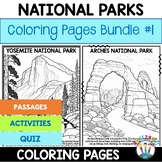155 results
Anatomy graphic organizers for Microsoft Word

Anatomy and Physiology: Mystery Skeletal System Diseases Case Study Activity
This activity is designed for groups to work together to solve the medical mysteries skeletal system diseases of 8 patients. It can be adapted and modified for smaller groups or even individual students. This activity will work as an in-person resource or a virtual learning resource. Students open the word document and the directions are listed at the top of the page for them to read. This activity is great for beginning steps in research and mimics what a lot of doctor's have to do in order to
Subjects:
Grades:
9th - 12th
Also included in: Anatomy and Physiology Mystery Organ Systems Case Studies Bundle
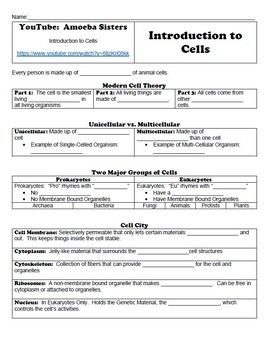
Student Handout for Amoeba Sisters: Introduction to Cells YouTube Video
This resource can be use to watch Amoeba Sisters: Introduction to Cells YouTube Video. As students watch the video they will fill in sentence frames about: (1) Cell Theory, (2) Unicellular vs. Multicellular Organisms, (3) Two Major Groups of Cells (Prokaryotes and Eukaryotes), (4) Cell City (Cell Organelles Functions), (5) Protein Synthesis- How To Exit The Cell, and (6) After Video Thinking Questions.This is a great, engaging video on Cells. Check out the Amoeba Sisters video by clicking on
Grades:
6th - 12th

Epithelial Tissues Table Worksheet
This is a table that lists all the types of epithelial tissues in the human body and includes a picture of what each type looks like under a microscope. The table also includes blank columns for students to fill in descriptions and locations in the body for each type. There are many different types of epithelial tissues and it is often difficult for students to organize the information. I have found this table to be helpful for them.
Grades:
11th - 12th
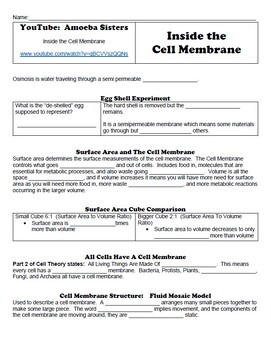
Student Handout for Amoeba Sisters: Inside the Cell Membrane
This resource can be used to watch Amoeba Sisters: Inside The Cell Membrane YouTube Video. As students watch the video they will fill in sentence frames about: Osmosis, Surface Area and the Cell Membrane, Cell Membrane Structures, Fluid Mosaic Model, Phospholipid Bi-Layer, Hydrophilic and Hydrophobic Molecules, Cell Membrane Components (Cholesterol, Proteins, Glycoproteins, and Glycolipids), Peripheral Proteins and Integral Proteins.This is a great, engaging video on the Cell Membrane. Check
Grades:
6th - 10th
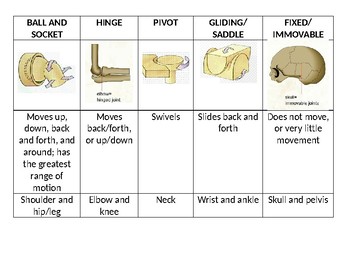
Types of Joints, Muscles, and layers of Skin organizers/sort
A combination of THREE completed graphic organizers. Each one is focused on a different system including: the types of joints, types of muscles, and the layers of the skin in the human body. If you are curious of the quality, you can download the Types of Joints sort/organizer for free from my page by clicking the following link: https://www.teacherspayteachers.com/Product/Types-of-Body-Joints-Graphic-OrganizerSort-1219523
This can be blanked out and filled in by students, be given as a refere
Grades:
6th - 12th
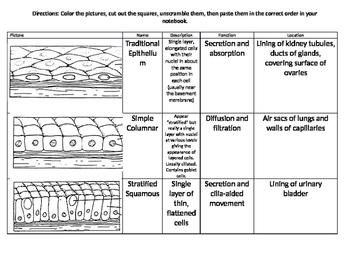
Epithelial Tissue Cut and Paste
Check out my Epithelial Tissue Cut and Paste from The Shoe Store. I used this in my Anatomy class to help my 11th and 12th graders learn the epithelial tissues. This activity contains 6 different types of epithelial tissues. I instructed my students to color the pictures, cut the squares out, unscramble the squares by matching the picture to its proper name, description, function, and location. I then had the students paste them in the correct order in their notebook. This is a great hands-on a
Grades:
9th - 12th
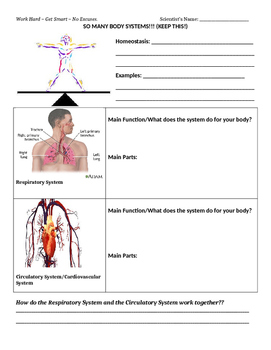
Body Systems Guided Notes
Template for students to take guided notes about each of the body systems: Respiratory, Circulatory, Nervous, Endocrine Immune, Digestive, Excretory, Skeletal, Muscular, Male Reproductive, Female Reproductive. The graphic organizer has a visual diagram of each system and a spot for students to take notes both about the functions and the main parts of each system. The Guided notes are to be used with the Body Systems Powerpoint.
Subjects:
Grades:
5th - 10th
NGSS:
MS-LS1-3
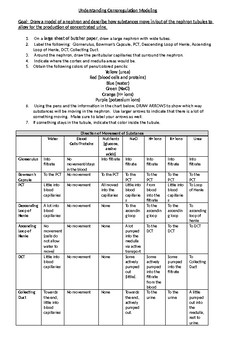
Nephrons: Building a model of how urine is made.
In this group activity, students use information on how substances are moving in a nephron to construct an explanation of how a nephron can create concentrated urine from blood plasma. Materials needed include large butcher paper (you could modify it by using smaller paper though), colored pencils or markers and the directions. Students should have a basic understanding of the structure of the kidney and have already been introduced to the structure of a nephron. You could also give them the
Grades:
10th - 12th, Higher Education
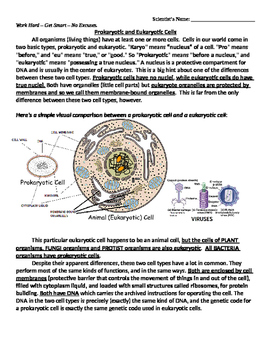
Prokaryote versus Eukaryote Cells
**Distance Learning and Remote Learning AppropriateThis is a basic informational introduction reading about prokaryote versus eukaryote cells. The reading is interesting and engaging and includes helpful diagrams. It includes follow-up comprehension and analyses questions, along with a helpful graphic organizer. The reading could be used for literacy groups, individual DEAR, science station activities, homework, etc.
Subjects:
Grades:
5th - 9th
NGSS:
MS-LS1-2
, MS-LS1-1
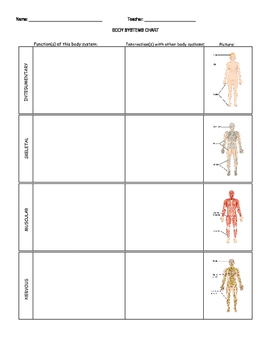
Body Systems Chart Worksheet
Students can fill out this 3-page chart on each of the following body systems:
integumentary
skeletal
muscular
digestive
circulatory
respiratory
endocrine
nervous
reproductive
lymphatic
excretory
This 6-page document actually includes TWO versions of the chart, one that asks students to list the function of each body system and how that body system interacts with other body systems and one that instead asks students to list the function and major organs of the body system.
This is a nice revi
Subjects:
Grades:
5th - 12th

Urine Formation (Nephron) Animation with Chart and Questions
Learning about how the nephrons in the kidney maintain osmoregulation can be very challenging for students to learn. I use this chart to help students solidify their understanding of what is happening in each part of the nephron. Students explore the animations listed to fill in the chart and then answer the questions as a formative assessment of their understanding.
Subjects:
Grades:
10th - 12th, Higher Education
Types:
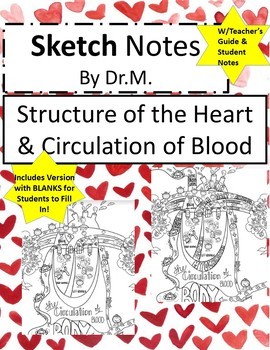
Heart Structure & Blood Circulation SketchNotes,Student Notes, incl FIB Version!
Product DescriptionThis resource includes all the information you will need to help your students understand the structure of the heart, as well as the process of how blood circulates throughout the body. Would you also like to teach your students how to draw an anatomically correct heart the EASY way? Check out my blog post here for step-by-step instructions and video! This is a great resource to use in conjunction with it! To see a step-by-step explanation of exactly how I use these Sketch No
Subjects:
Grades:
6th - 12th, Higher Education

Human Body Student Booklet
Trying to teach the human body and just don't like the curriculum given to you? Well fret no longer! Included in this human body booklet is a unit study that can be substituted for the regular old textbook. The study is on 6 of the human body parts: skeleton, muscles, heart, lungs, stomach, and brain. Each body part has a page for 5 facts, a page that states "I learned about the *body part* by _____" and "The most interesting thing about the *body part* that I learned was ______", and also a bla
Grades:
1st - 5th
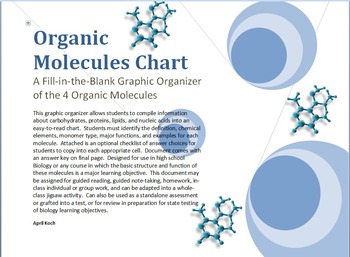
Organic Molecules Graphic Organizer
This graphic organizer allows students to compile information about carbohydrates, proteins, lipids, and nucleic acids into an easy-to-read chart. Students must identify the definition, chemical elements, monomer type, major functions, and examples for each molecule. Attached is an optional checklist of answer choices for students to copy into each appropriate cell. Document comes with an answer key on final page. Designed for use in high school Biology or any course in which the basic struc
Grades:
9th - 11th
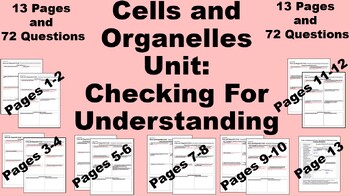
Cells and Organelles Unit: Checking For Understanding- 72 Questions and Answers
This resource is a Checking For Student Understanding about Cells and Organelles. This resource is 13 Pages with 72 Questions and Answers. Print out one copy for each class, and use these questions as you circulate around your classroom as students are working on independent work. You can use these questions to Check for Student Understanding of the Content, annotate on your paper who is mastering the content and might need Enrichment for the topic, and annotate on your paper who might need Re
Grades:
6th - 12th
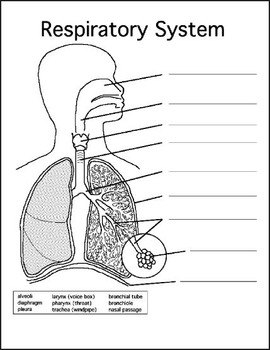
Respiratory System Graphic Organizer
This is a way to organize notes about the functions of the organs in the respiratory system. Organs included are: nose, pharynx, larynx, trachea, bronchi, lung, bronchioles, alveoli, and diaphragm.
Grades:
6th - 8th

Brain Graphic Organizer and Puzzle
Students write notes labeling each part of the brain and its function.
Then students put the puzzle together so that they have a graphic organizer full of information as a reference for later.
Includes the cerebrum, frontal lobe, parietal lobe, occipital lobe, temporal lobe, cerebellum, and brain stem.
Great for a unit on neurology, neuroscience, and the brain.
Subjects:
Grades:
3rd - 12th, Higher Education
Types:
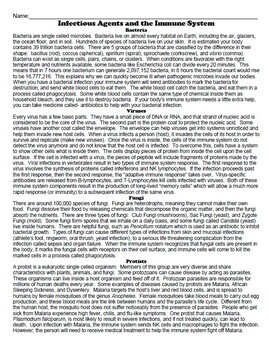
Infectious Agents and The Immune System: Bacteria, Virus, Fungi, Protist
This resource is a Read, Think, and Draw about Infectious Agents and the Immune System: Bacteria, Virus, Fungus, and Protist. Through the reading students will learn about: Bacteria, Where Bacteria Are Found, Shapes of Bacteria, Bacteria Division and Cell Reproduction, How the Immune System Defends Against Bacteria, White Blood Cell, Antibodies, Phagocytosis, Antibiotics, Viruses, DNA, RNA, Nucleic Acid, Interferons, Natural Killer Lymphocytes, Immunity, Antibodies, How the Immune System Defend
Grades:
4th - 12th
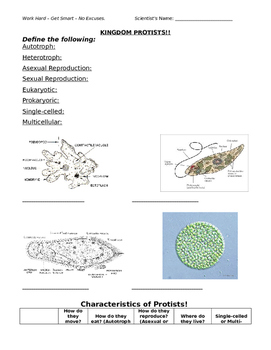
Protists Review Guide
This is a basic review of the four main protists: Amoebas, Paramecium, Volvox, Euglena. It also reviews the important vocabulary when talking about protists: Autotroph, Heterotroph, Asexual Reproduction, Sexual Reproduction, Eukaryotic, Prokaryoric, Single-celled, and Multicellular. The assignment reviews the important characteristics of protists in a graphic organizer: How do they get their energy? How do they move? SIngle-celled or multicellular? Where do they live? How do they reproduce? T
Subjects:
Grades:
5th - 9th
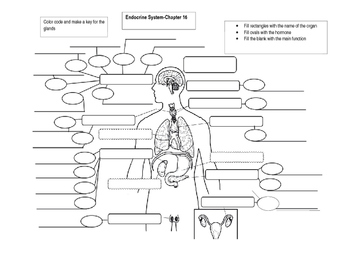
Endocrine System labeling and concept map
This is essentially a graphic organizer of the endocrine system. Students label the glands, identify the hormone(s) secreted by each, and then describe the functioning of these hormones. It is a great way to review and put everything together!

Human Body Functions and System Relationships Activity
Each group of students (3-4 students), will have a system assigned to them. Each system is color coded and the handout includes a "System Man" outline and a copy of systems/ organs that fit perfectly into the man. I also included a chart (organizer) for students to write the function of each system, and how each system relates to the function of other systems. If you are in Texas, you have noticed that our STAAR test for 8th grade has asked questions about how multiple systems function togeth
Subjects:
Grades:
6th - 10th
Types:
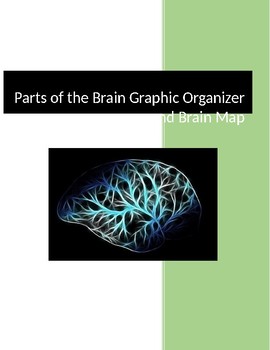
Parts of the Brain Graphic Organizer and Brain Map
The Parts of the Brain Graphic Organizer and Brain Map were created to coincide with Unit 3 Biological Bases of Behavior. All the major parts of the brain are included on the graphic organizer with space provided for their function and a mnemonic device. Included is also a side view of the brain, for students to label. This activity works well for students to complete as the teacher lectures or on their own. In addition, students could work in pairs to create their own mnemonic devices to help t
Subjects:
Grades:
9th - 12th
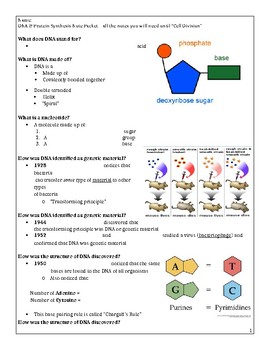
DNA and Protein Synthesis Guided Notes
This purchase is a 9-page set of guided notes to accompany the 68 slide power point presentation I also have on my store page. The power point outlines DNA structure, the history of how DNA was discovered, properties of DNA, as well as DNA replication, transcription, translation, and mutations.
Both the notes and the power point are EDITABLE so that you as the teacher can add and remove what is necessary for your students! Enjoy :)
Subjects:
Grades:
9th - 12th

Photosynthesis and Cellular Respiration Unit: Vocabulary, Word Search, AnswerKey
This resource is a Photosynthesis and Cellular Respiration Unit Vocabulary and Word Search. Students will look up the definitions of 18 vocabulary words, and then find 31 words in a word search. This resource is four pages. Page 1: Photosynthesis and Cellular Respiration Unit Vocabulary with 18 words. Page 2: Photosynthesis and Cellular Respiration Unit Word Search with 31 words. Page 3: Answer Key for Page 1. Page 4: Answer Key for Page 2.Want a quiet activity for your students to work on if th
Grades:
6th - 12th
Showing 1-24 of 155 results




